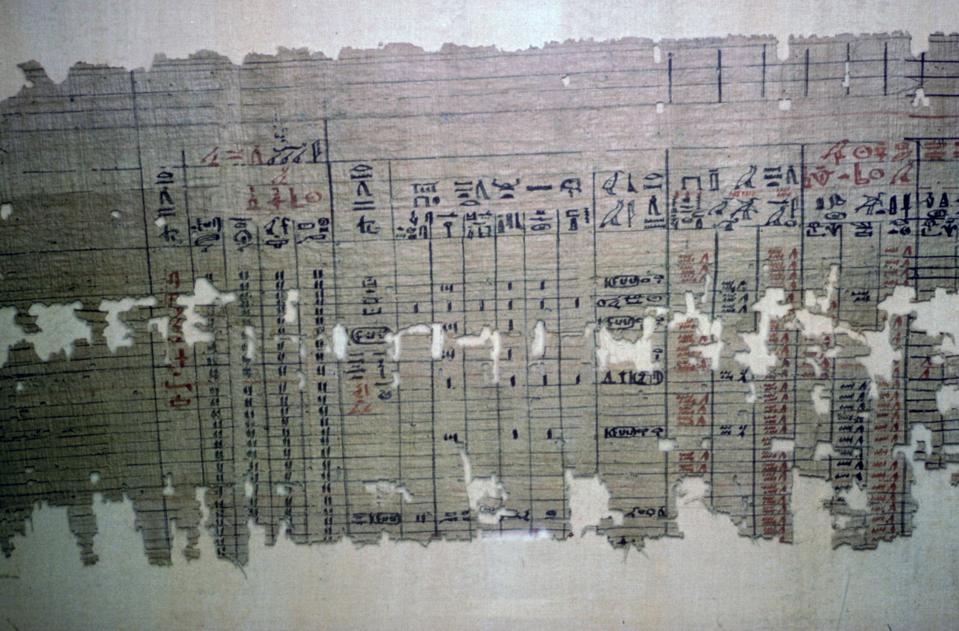
Egyptian monthly accounts from the archive of a temple, similar to a modern spreadsheet in analysis. From the Louvre’s collection. (Photo by CM Dixon/Print Collector/Getty Images)
Print Collector/Getty Images
This week, there is a very stark example of how things are changing in the race toward artificial intelligence.
This involves a household name model, and an administrative technology that’s instantly familiar to most personal computer users.
Namely, OpenAI’s ChatGPT and Microsoft Excel.
The latter is a piece of Microsoft’s traditional Office suite that’s dominated basic software for a decade. Many millions of entry-level clerical workers have demonstrated their prowess with this top spreadsheet in order to get work. Microsoft built its brand on dominating parts of the market like this, while also pioneering the Windows-based GUI.
But that was a while ago.
Now, ChatGPT is taking over that piece of a new market that has to do with using the spreadsheet itself.
Essentially, ChatGPT will make many of those basic clerical workers redundant.
That’s because in addition to its existing capabilities, the model can now use Excel in highly cognitive ways – like a person.
Data and Data Handling
Let’s contrast the new ChatGPT capabilities with what we already had earlier in the game. In ChatGPT’s nascent development phase, the technology was helpful in aggregating data. Humans could put that data in a spreadsheet, conceivably, or use it for any number of other things.
Then, ChatGPT became adept at writing basic Excel functions and formulas for us. Think of multipliers and sums, for example. ChatGPT itself came up with this instance:
Old way: You had to know =IF(AND(A2>100,B2=”Yes”),”Approve”,”Reject”) by heart.
ChatGPT way: You just say:
“If column A is greater than 100 and column B says ‘Yes’, mark it as Approve.”
ChatGPT instantly gives you the formula — correctly formatted.
This was part of the vibecoding revolution, where programmers and symbolic analysts realized that they could just use AI to do their work. Hard coding became a thing of the past – just ask the model to do it. And we were still ingesting this democratization of programming when brand new capabilities came along.
The New Way
The new ChatGPT, it is alleged, will be able to open a spreadsheet and populate it, and create results all on its own, without human oversight.
That’s a new realm of automation that deserves its own accolades, and perhaps its own concern, too.
The Information reports on these groundbreaking steps by OpenAI, which seem to encroach on Microsoft territory.
Apparently, part of the capability involves creating files that are compatible with MS Office tools Excel and Powerpoint, so that the user doesn’t need these applications (or the corresponding licenses) to make something that’s compatible with outside software.
“New tools under development will allow users to create and edit spreadsheets and presentations directly within ChatGPT, eliminating the need for Microsoft Excel, PowerPoint, or any Microsoft software access,” writes Vasudha Mukherjee at Business Standard.
A Wired article by Reece Rogers last week goes into more detail. In the tech media’s coverage of this, there’s a real “it slices, it dices” feel to the reporting – as if the new ChatGPT will be that next way station toward office automation that some have been waiting for, and others have been dreading.
Documentation of Capability
Over at GitHub, you can read more in a readme file attached to project-related items.
“ChatGPT-4, the latest iteration from OpenAI, has demonstrated impressive abilities in linguistic processing and task execution, particularly in the realm of Excel spreadsheet management,” writes a user with the handle Ameenha23. “However, it encounters significant challenges that limit its effectiveness in more complex Excel functionalities.”
This author notes that the new model “shows a profound understanding of Excel’s operational framework,” enabling it to do analysis and a range of tasks.
“Beyond basic data manipulation, ChatGPT-4 excels in automating repetitive Excel tasks, such as data entry, basic calculations, and standard report generation,” Ammenha23 adds. “Its interactive support feature provides users with step-by-step guidance on various Excel functionalities, helping them navigate through complex procedures and troubleshoot common issues. This aspect of ChatGPT-4 significantly enhances user experience, making it a handy assistant for both novice and expert Excel users.”
Accountant Using Online Spreadsheet For Fraud Investigation
getty
All of this illustrates the uncanny power of the LLM to “use” a spreadsheet in eerily human ways.
Unlike the old funny paper clip avatar of the past, the model, though not endowed with a visual avatar, is going to be a user. Like Claude and its predecessor, these new agents will be able to use software pretty much just like we humans do. And it’s naïve to think that we won’t be in direct competition with them.
So I thought this innovation deserved its own spotlight now, in July of 2025. You don’t have to wait long to get a better look at these technologies. I’m guessing that by September, we’ll already see them exploding into the workplace, and sending a lot of those human spreadsheet writers home to reskill, or whatever you’re supposed to do to survive the job displacement of the 21st century.
At the same time, there are obviously lots of benefits to society as a whole. Perhaps, like some of the contemporary titans of industry have been saying, we’ll use people to do more creative things and higher level things, while AI does the grunt work. Either way, it’s clear that ChatGPT is acquiring the capability that it needs to do all kinds of human office tasks.

